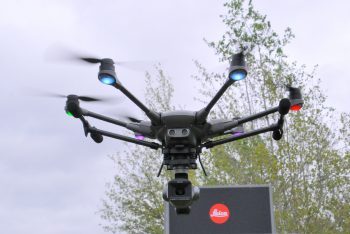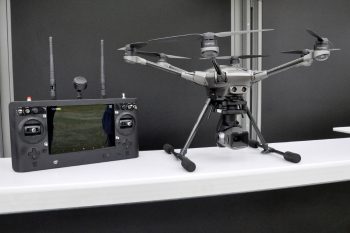In English
Interview Yuneec: strategy, Leica, future device, regulation ...
Par
dp -
1 Oct ’19
6

Wenyan Jiang, founder and president of Yuneec. Photo credit Marc Mitrani
I had the opportunity to meet Wenyan Jiang, the founder and president of Yuneec, and Jörg Schamuhn, CEO of Yuneec Europa. The interview took place at the Yuneec H3 launch press conference and its Leica Ion L1 Pro camera in Wetzlar, Germany. This interview was done in collaboration with my colleague Marc Mitrani, who works for several publications, including The World of Photography.
Helicomicro: Tell us about your company, Yuneec.
Wenyan Jiang: We started our business in 2007, we made electric planes. We have almost been the pioneers in this aviation sector. We have faced the crisis of 2008, which has led us to stop investing more in electric aircraft, but we are still working on it. In 2011, we started producing drones.
HM: Yuneec is a Chinese company?
WJ: We are handling and manufacturing in mainland China, but Yuneec is based in Hong Kong, not China. We started our aerospace business in the United States and Europe.
HM: When did you start working with Leica?
WJ: In Asia, I think too much money is invested in production. The competition is difficult, you have to be different. I think I met Leica when we started producing drones, but it was only a first contact. Parking at home, the in-house drones were less active than the beginning, but the Lesbianets industry is now growing, and it has developed as a software-based contraire. The material is still important, but it has now become a platform for carrying cameras.

HM: Why Leica?
WJ: During those 20 years, I dreamed of a strategy based on the Yuneec brand, and many people did not agree with me. But for me, the brand is very important, and Leica has a rich legacy. First of all, we have known each other for a long time and we trust each other. But Leica is also recognized as a high-end camera company. It's a very good brand.
HM: Have you signed an agreement with Leica?
Jörg Schamuhn: Yes, there is a sealed agreement for 5 years. It's a 38-page contract. But I'm pretty sure Wenyan Jiang wants him to last for more than five years.
WJ: There is indeed a contract, we need it. It is only the first step, we need to work closely together in the future.

HM: How is this partnership organized?
WJ: We have Yuneec engineers in Zurich, we also have engineers based in Shanghai.
JC: On the Leica side, there are two teams. Leica has set up a drone development team at its headquarters in Wetzlar, Germany, and a Leica project team in Shanghai. They work together. From our headquarters in Hamburg, at Yuneec, we are in charge of the project management part. We work together for the professional market, but not only, we also work on consumer devices.
HM: When will the Typhoon H3 and its Leica camera be available?
JC: We plan to ship the product in the last week of October.

HM: Is the camera only sold with the Typhoon H3?
JC: The drone with the Ion L1 Pro is sold 2399 euros including taxes. To answer your question, the Ion L1 Pro camera alone costs 1499 euros.
HM: Does this mean that it will be usable on Typhoon H +?
JC: We are working on a way to adapt it to the Typhoon H +. So yes, it's planned.
HM: Can you use the previous H Series cameras on the Typhoon H3?
JC: Yes. You can use a C23, a CGO3 +, thermal cameras ...
HM: What about the zoom?
JC: What has been implemented on the Ion L1 Pro is a lossless digital zoom. When Chinese manufacturers talk about digital zoom, it's basically an enlargement that does not take into account the quality of the image. Leica has a very particular algorithm for recalculating each pixel, which is what they call lossless zoom. It keeps the sharpness of the image.

HM: Do you envisage a camera with optical zoom?
JC: What I can say is that we currently have a prototype optical zoom camera that goes around the world. It has been used in the United States, France, the United Kingdom, Israel, Switzerland. I am planning a commercialization of this optical zoom solution by the end of this year. So we're not just considering it, we're going to market it. We are planning a 30x optical zoom combined with an 8x digital zoom.
HM: Will it be usable on the H3 and the previous devices?
JC: It will work on Typhoon H + and H520, and we will make it compatible with the Typhoon H3, yes.

HM: Has the sound level of Typhoon H3 been reduced?
JC: No, it's the same as the Typhoon H +. From H to H +, we increased the diameter of the motor arms, which allowed us to use larger propellers and a lower rotational speed. But the mechanical geometry of H3 is similar to that of H +. We are working on carbon fiber propellers with winglets that will allow pilots to take off and fly at high altitude.
HM: Will you still produce consumer devices?
WJ: We're going to take a step back on this category ...

JC: The observation is that the Baker, Amazon, MediaMarkt, etc. are looking for aggressive prices, large volumes, huge contributions to marketing, and it is very painful. They are one of the reasons why the mainstream UAV market is in trouble. Wenyan Jiang chose a strategy, she wants to return to more quality, not only in the product, but also in distribution and sales. What we are going to do now is a top-down approach. Not all retailers will be allowed to buy the H3, we will do what we call selective distribution.

We will resettle a base similar to that of photo specialists, people who can take care of the product, with knowledge of the technology, with the possibility of giving advice to the customer. We will sell exclusively to specialized resellers, so as to obtain price stability.
HM: Is this a long-term strategy?
JC: Yes. When we have established this base with the Typhoon H3 and Ion L1 Pro camera, we will move on to the next product, which will be positioned at a slightly lower price. We will use this platform to allow distributors to obtain sales volume. This strategy will keep us away from the fierce competition between no-name products.

HM: But you just unveiled Mantis G!
JC: The Mantis G is positioned more entry-level than the product we are developing for the next generation I talked to you about.
WJ: The number of products we sell is not huge, unlike some of our competitors. In fact, I do not like this kind of market saturation. I come from general aviation and the sky is a very important resource for me. I do not want to see him saturated. This can lead to security issues with general aviation. I tend to think that the price should be higher so that everyone can not buy for drones, for security reasons. That's why I see cooperation with Leica as not only a way to improve quality, but also to limit quantities. I think it helps the industry to
develop healthy.

The ND filter system of Leica.HM's Ion L1 Pro camera: Do you develop technologies to enhance security, such as ADS-B?
JC: This area depends a lot on regulation. Unfortunately, there are several very different approaches. What we are currently doing is R & D, research into technologies such as transponders, passive identification tools such as ADS-B and RFID. But we have no wish for concrete implementation, because at the moment the legal norms are not determined. The FAA is considering ADS-B, India already requires RFID, EASA is studying passive transponder technologies. In addition to that, you have the U-Space and its requirement to broadcast information in real time from the device. The guidelines will mature very quickly because EASA is under enormous pressure, since Europe is preparing a new drones regulation on 1 June 2020.HM: What about France and its Wi-Fi identification requirement? devices over 800 grams?

JC: For clarity, we are able to integrate ADS-B very quickly, as well as Wi-Fi identification by a software upgrade because we use WiFi on board. What is more complicated is the transponder technology, which requires a lot of computing power on board. Since we are talking about it, the on-board computing capability is also a difference between H and H3. The Typhoon H runs on with Intel M4 processor, the H3 with Intel M7.HM processor: Will RealSense technology be available on H3 for customers who want to take advantage of a better solution to avoid obstacles?
JC: It's still in our program, but I'm saying we're working on lighter alternatives based on the PX4. The problem is that when you want a 360 ° obstacle avoidance, you need 4 RealSense modules that add 500 grams to the drone, which halves the payload. Our Zurich office already has a solution, we will deploy it when it is appropriate to do so.













